I came across a question recently about overheated Revere Ware:
How to remove a gray stain on interior of Revere ware Copper bottom stainless steel 7inch fry pan
The gray stain was caused by heating the pan for over 5 minutes after the boiling water in it was boiled away because I was momentarily (5+ minutes) distracted away from the cooking range.
Is there a method and a special compound/solution which I can use to restore the appearance to its nearly new shine instead of the dull gray look? Is the pan still usable in its present state? Will there be release of any metallic toxins because of the overheating of the pan in its dry state?
I’ve also had people contact me directly with the same problem and concerns about any ill health effects.
To answer her last question first, it is worth noting that it is unlikely that anything related to the stainless steel will cause health problems. I have friends that are nervous about stainless steel because it has chromium in it, but the type of chromium used in stainless steel, chromium III, which provides the corrosion and discoloration resistance stainless steel is known for, is completely unlike the very deadly hexavalent chromium made famous by the film Erin Brockovich. In fact, chromium III is required by the body in trace amounts for proper digestion of sugars and fats.
In terms of the health of the cookware, it is always a bad idea to heat a pan without anything in it for an extended period of time, because this will likely warp the bottom of the pan, effectively ruining it.
To determine an effective repair for any discoloration, I set out to duplicate the problem.
Heating the pan without anything in it for a good 15 minutes didn’t cause any discoloration at all, but it had a pretty harsh affect on the copper bottom.
The extreme heat caused little pieces of the copper bottom to flake off and made the bottom rough to the touch.
Next I tried the experiment with some water in the pan, let the water boil off and heat for a good 10 minutes after the water was gone.
This time there were burned on hard water stains and some iridescent discoloration. As we don’t have particularly hard water where I live, I suspect this would be much worse where there was very hard water, and probably the cause of the discoloration in question. I have gotten pans in such shape from thrift stores and the solution below also did wonders on them.
While any warping caused by such heating will likely be permanent, the stains and discoloration on the inside of the pan are fairly easy to correct: simply scrub well with a Scotch Brite pad (never use steel wool or SOS pads) and then polish with some Bar Keepers Friend. Looks much better. It is important to note that a Scotch Brite pad should NOT be used on the outside of the pan as it will dull the finish. The inside of any pan will become dulled anyways from use, so a Scotch Brite pad won’t hurt it any worse.
The bottom was more difficult to polish; I tried Bar Keepers Friend and copper polish, but the roughened surface due to the over heating made it more difficult to get good results.
There is one more danger to overheating pans; the Bakelite handles can break down at high enough temperatures. This particular test resulted in some slight breaking down of the Bakelite material where it touched the metal.
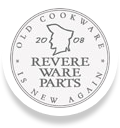
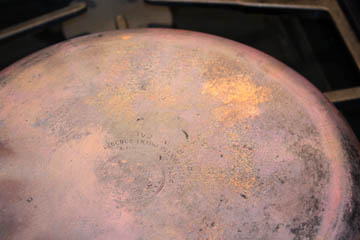
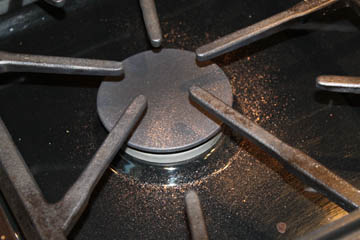
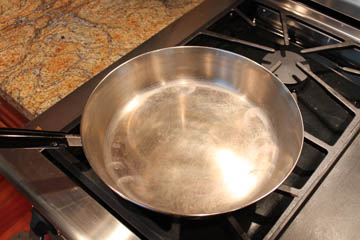
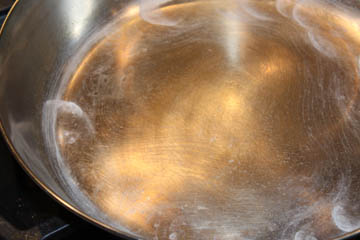
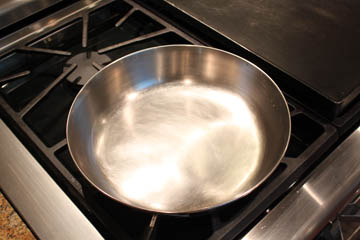
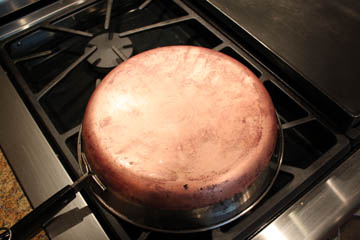
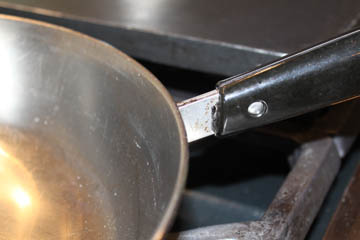
Thanks for this explanation.
I was very concerned about using my revere ware to cook acidic food and wondering if it does react with acid as aluminum cook ware does .
Thanks
Aluminum in general is a poor choice for cookware given its reactive tendency (such as with acidic foods) and the uncertainty about health issues with aluminum exposure.
Stainless steel has none of the same issues as aluminum (none of the elements in stainless steel have health concerns) and is non-reactive with acidic foods.
I did the same thing and now the bottom is rough like the pictures! Do I just keep trying with bar keepers friend and copper polish? There didn’t seem to be a solution in this article.
I suppose it could be mechanically polished by a professional metal finisher to smoother it out, but there is little benefit to that. You’ll thin out the copper layer and it will be less effective and spreading the heat. You can bring back the bright copper color but are likely stuck with the roughened bottom look. It shouldn’t affect teh use of the pan though.
I have had my revereware since I was 18 I am now 58. . And before that while growing up my mom also had it. She passed away at 90 recently but the cookware still exists and is still going strong.
I cant tell you how happy I am and have always been with my copper bottom Revere ware.
Best product Ever. Thank you for lifetimes of great food. Sincerely Jayne Kinney
I tried ketchup over night. It helped a lot!!
Well, I did use a Brillo pad, Comet and a scothbrite-type pad. no results to the burned out water in my pot (small, 1 qt size) MAybe I made it worse with the Brillo and Comet.
Any more thoughts?
I know steel wool is bad to use on stainless steel because they can promote rust; I suspect Brillo pads are the same.
If you tried a knockoff Scotch-Brite pad, try the real thing. You can also try Lime-Away or vinegar to break through the hard water residue.
I left my copper pot, I mean I forgot it for like 30 minutes and now I don’t know if I can use it again, it is healthy. You can see that it is overheated and the color form copper became like rainbow
Is it healthy?*
There is nothing unhealthy about the rainbow sheen in stainless steel. When you overheat the pan, it promotes a reaction between the chromium (healthy kind) and oxygen, which creates a thicker chromium oxide layer in some areas. The chromium oxide layer is what makes stainless steel protected from rust. The uneven chromium oxide layer causes the light to refract differently at different wavelengths in different areas which causes the sheen.
Will this make anyone sick?!! It’s Thanksgiving today!! – – -Please Respond Within 5 HOURS.
– It is now very early Thanksgiving morning.
Thank You!
Last evening, for the first time ,I made cranberry sauce in a Paul Revere pot ( the classic Paul Revere line of cookware). The finished cranberry sauce taste fine, seems fine and I taste tested Often. BUT when I rinsed out that pot the darkening over time of the inside of that pot was gone!! It was now as shiny and crispy Bright as if it were new. I assume the cranberry acids had something to do with it. In exchange has my cranberry sauce been affected by any leeching from the pot that will HARM MY FAMILY?? Help I don’t want anyone to fall ill – there are children too. – I feel fine however.
The darkening over time is almost certainly hard water deposits that got attached to the bottom of the pan over time, and blackened as the minerals got burnt from the heat. The cranberry sauce must have dissolved the minerals, like vinegar will given time, and they ended up in your cranberry sauce. So, not dangerous.
In general the inside of your Revere Ware is pure stainless steel. There is nothing about it that can be harmful, just iron with a few other elements added to make it not rust.
Try soaking in ketchup
I can’t believe I found this! I have boiled out water in more than 1 revere pan. (whoops!) and as they were my mother’s and my favorite pans, I didn’t want to get rid of them. THANKS!
I have always used sos on my pans. I guess I should stop.
Additional question: It looks in these pictures as though some of the copper has come off. “Flaking” So–if that’s the case, is there more copper underneath that stayed? or is the copper-bottom no longer copper, and therefore not as useful?
How much copper there is depends on the vintage. The pre-1968 era pans have quite a lot of copper so a little flaking off will not likely change the pan much. However, the newer stuff often has a layer that is very very thin (cosmetic only) and doesn’t do much for spreading the heat like the original era pans did. I’ve heard many stories of this copper simply wearing off after a moderate amount of use.
I sell alot of Revere ware on eBay. If you have discoloration on outside pollished stainless steel. You can run a buffer wheel to clean them up. It also does wonders for the copper bottoms. It removes all sctatches. I did how ever put them in dishwasher and they turned green. I resolved this issue by rebuffing the bottom copper then used a polish brasso and it never turned green again. The brasso had oils in it to keep the copper ffrom turning green in the dishwasher. The buffing wheel will clean all grime off the whole outside of the Revere ware. Just make sure to use a polish to finish the job.
Are the oils in Brasso OK to use near food? I might suspect that they are not.
For something like this it is always helpful to look at the materials safety data sheet (MSDS) for a product. You can find the one for Brasso here.
In particular, it says:
So, probably best not to use near food. However, I’ve seen indications that simply washing something well with soap and water will get rid of any residue.
Hello RevereWareParts — What do you suggest to do for flaking copper on the bottom of a pan that has overheated?
There really isn’t much to do except scrub it with a non-scratching scrubber to get any loose flakes off, and then polish it really good a couple of times with copper cleaner.
I left my Mother’s pre-1986 3 qt pan on the stove as the water boiled out without me knowing -some of the the copper bottom actually came off and the inside is dark -after I cleaned it, I used it again to boil macaroni and it just did not taste that good -I will try to clean it again -inside and out -but I think I will be buying her a new pan. I still have not told her -I think it was the first pan they bought when they set up housekeeping back in 1951. Ouch / I will have to ask my brother about a buffer? Thanks Trevor and Peter
I cook steel cut oatmeal in an old 2 quart Revere Ware sauce pan for 2-3 minutes. Letting the pot sit over night softens the oatmeal requiring little additional heating to make it palatable. However, shortley after the initial heating, while cooling, I get a copper stain around the edge of the oatmeal. Never had a problem with my ceramic coated pots.
My 1-QT pot was left to boil dry (by a roommate) and now there are some uneven places in the surface that feel like wobbles or ripples. I can feel them on both inside and outside of the pan. This set was purchased in 1982 or ’83, so I presume it’s the less stable product than the ones we had in my childhood home that were purchased in the early 50s. Is this pan permanently damaged or is it safe to use?
It sounds like your pot was permanently warped.
There is nothing dangerous about it; it is perfectly safe to use. Often times warped pots or pans work fine on gas-type stoves that have the prong-type grill on which the cookware sits. Where warped pans run into trouble is on flat stoves. Many people, including myself find a wobbly pot very annoying. Additionally, because it doesn’t make full contact with the burner surface, it probably won’t heat well.
Hi, I recently heated an 1801 saucepan without water in it (the bottom of a steamer), and not only did the inside turn that dark rainbow sheen, but the outside of the copper-bottom has several bubbles around the rim. Is it safe to use? Is there anything I can do to fix that? If not, and it’s still safe, I’m okay with that, safety is my first concern.
Nothing unsafe can happen from the overheating of stainless steel. The sheen on the inside is just from increased oxidation of the chromium in the steel with oxygen, causing an uneven layer which defracts light differently depending on thickness. The chromium oxide layer is what makes stainless steel stainless.
As for the bubbling in the copper, it’s unfortunate and there really isn’t anything that can be done about it. I’ve got a few pans that have had that happen to them and while somewhat unsightly, the pan should still perform pretty well. I just polish them the best I can with copper polish.
Best thing I’ve found to clean copper bottoms on the outside is table salt and ketchup.
I recently experienced a house fire…. recovered all of my Revere Ware…the handles and knobs are all burned off but the kettles and fry pans look okay – my husband thinks they aren’t useable…. What is your opinion?
I can’t see any reason why they wouldn’t be usable once they are cleaned of any debris and soot, and the Bakelite parts are replaced. I’d love some pictures of the before and after for our blog.
I have two revere pots. One pot looked dark and tarnished inside. I applied tarnish remover and noticed the towel was grey removing some of the tarnish but it is still tarnished. How can this be rectified? Not sure how the pot got this way since it was purchased at a thrift store.
It is more likely burned on hard ware deposits. I would try a vinegar soak that you heat repeatedly and then scrub with a green Scotch Brite pad to agitate the surface. There can be small pits in stainless steel from cooking acidic foods that hard water deposits can hide in, so it might take a little while using this method to get them all.
I overheated a small fry pan big time. A rice paper-thin layer of copper oxidized and flaked off when rubbed (very messy). The inside bottom of the pan was black. Scouring powder with a blue pad (don’t have any green) did nearly nothing. So I used one of those nail boards, not the sandpaper type, but the new type with the foam between emery cloth-type abrasive. Took it right off using a bit of water and a circular motion, rub it.
Be sure to scrub the pan well with soap after, then boil an inch or two of water and check the water to see if it’s scummy. Repeat this if needed until the water looks good.
I believe the excessive heat caused carbon to migrate out of the stainless steel onto the surface.
What causes tiny copper colored specks in the inside bottom of copper bottom saucepans? Are they still safe to use?
On the inside bottom, I have no idea. Could you possibly have put another cobber bottom pot on top of it that some of the copper flaked off into the inside of that one?